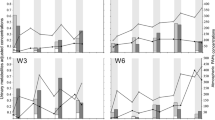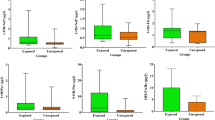Abstract
PAHs form during the incomplete combustion of organic substances and hence they are distributed ubiquitously in the environment. PAHs in the diet are the main source of exposure in man. In 1997 a new source of potential PAH exposure was discovered: very high levels of polycyclic aromatic hydrocarbons (PAHs) and benzo-a-pyrene (BaP) were detected in household dust from former American Forces housing in Frankfurt am Main, Germany, built in 1955/1956. This contamination was caused by a parquet glue containing coal tar, the use of which was formerly standard building practice in Germany. Because the inhabitants of these flats were very concerned about the effects on their health, they were offered the opportunity to take part in biomonitoring examinations to assess individual internal PAH exposure. Participants and methods: 1213 inhabitants from 511 flats/houses took part in the investigation; this corresponds to 12.7% of the total inhabitants of the former US housing estates in Frankfurt am Main. Spot urine samples were collected and frozen until analysis for 1-, 2-, 3- and 4-hydroxyphenanthrene and 1-hydroxypyrene, which was carried out using a very sensitive and practical high performance liquid chromatographic method with fluorescence detection, approved by the Deutsche Forschungsgemeinschaft. Results: The level of internal exposure to PAHs in study participants living in homes where parquet glue containing PAHs had been used did not differ from the levels found in particpants in whose homes PAH-containing parquet glue was not used. This was true for the whole group as well as subgroups divided according to age and smoking behaviour. Internal exposure was not influenced by different levels of external exposure (BaP in parquet glue and in household dust). Spearman rank correlations between the level of BaP in parquet glue and in household dust were low and insignificant. Conclusion: An increase in internal PAH exposure due to high levels of PAHs in parquet glue and household dust could not be detected. This confirms earlier results with small collectives, where only low and insignificant trends were found towards higher internal PAH exposure caused by contaminated homes. Therefore, the ad-hoc working group of the Commission for Indoor Air Quality of the German Federal Environmental Agency stated that a definitive threshold limit value cannot be defined for PAH contamination in parquet glue and household dust. For reasons of disease prevention, however, BaP contamination in household dust exceeding 10 mg/kg should be minimised
Similar content being viewed by others
Author information
Authors and Affiliations
Additional information
Received: 9 June 2000 / Accepted: 31 October 2000
Rights and permissions
About this article
Cite this article
Heudorf, U., Angerer, J. Internal exposure to PAHs of children and adults living in homes with parquet flooring containing high levels of PAHs in the parquet glue. Int Arch Occup Environ Health 74, 91–101 (2001). https://doi.org/10.1007/s004200000214
Issue Date:
DOI: https://doi.org/10.1007/s004200000214




